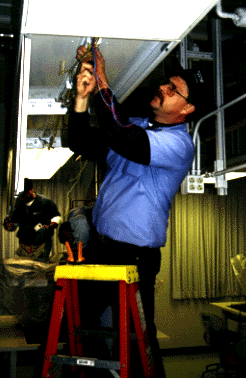![[Currents header graphic]](/homeart/currents_header.gif)
![[Currents header graphic]](/homeart/currents_header.gif)
January 19, 1998

|
|
Mike Edens changes the wiring for a lighting fixture in Thimann Laboratories
|
Work crews began upgrading and replacing light fixtures in state-funded areas of the campus earlier this month.
More than 3,000 offices, laboratories, classrooms, and other spaces will gain new full-spectrum fluorescent lights and electronic ballasts (devices that regulate the flow of electricity). Some will even receive new lighting systems.
The lighting retrofit project is part of an overall drive by Physical Plant to make the campus more energy-efficient, said project manager Jim Dunne. "The main crux is we wanted to increase the energy conservation of the campus," Dunne said. "Our thinking was, if the technology is available, let's do it."
By installing energy-efficient lighting fixtures, the campus anticipates reducing its use of energy for lighting by as much as 20 percent and improving overall lighting quality. The $1.6-million project is expected to be paid for with energy savings over a six-year period.
UC Santa Cruz is already the most energy-efficient of the nine UC campuses based on its use of energy per square foot.
People will see several improvements with the new fixtures, said project inspector Pete Butterworth of Physical Plant. The new electronic ballasts are quieter than the old ballasts, and they allow the lights to operate at a higher frequency, eliminating the flicker often seen with fluorescent lamps. And the new fluorescent bulbs provide a warmer, more natural light: "More like outdoor light," Butterworth said.
AMTECH Lighting Services of San Jose has contracted with the university to perform the work, which is scheduled to be finished in mid-June.
Since work began January 6, crews worked in several areas of the campus, including Thimann Laboratories and the Hahn Student Services Building. Staff and faculty who want to know when crews will reach their own work spaces should talk to their building coordinator, said Dunne.
The project was originally scheduled to start in August, but was delayed due to funding and legal issues, said Bob Dunn, campus energy manager. With this project, UC Santa Cruz is participating in the Environmental Protection Agency's Green Lights Program, Dunn said. The program's goal is to reduce the production by power plants of air pollution and greenhouse gases.
Most of the work is taking place in the evenings and on weekends to reduce the impact on the students, faculty, and staff who use the facilities. Some of the larger projects will take place during spring break.
In the future, Physical Plant plans to further increase the campus's energy-efficiency by installing a high-efficiency air chiller in the Earth and Marine Sciences Building and upgrading the campus's energy-management system, which turns fans on and off and regulates air conditioning and heating systems.